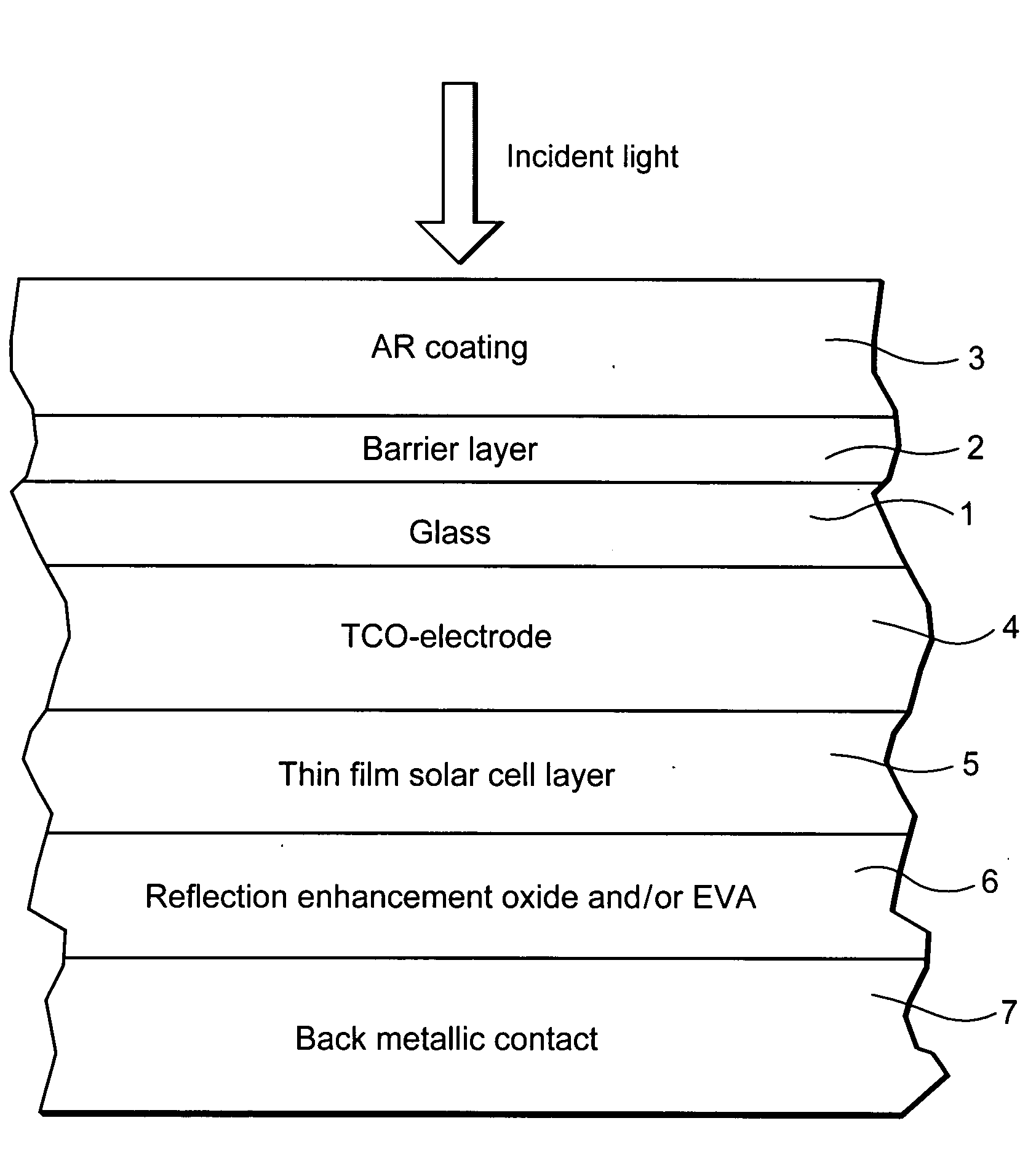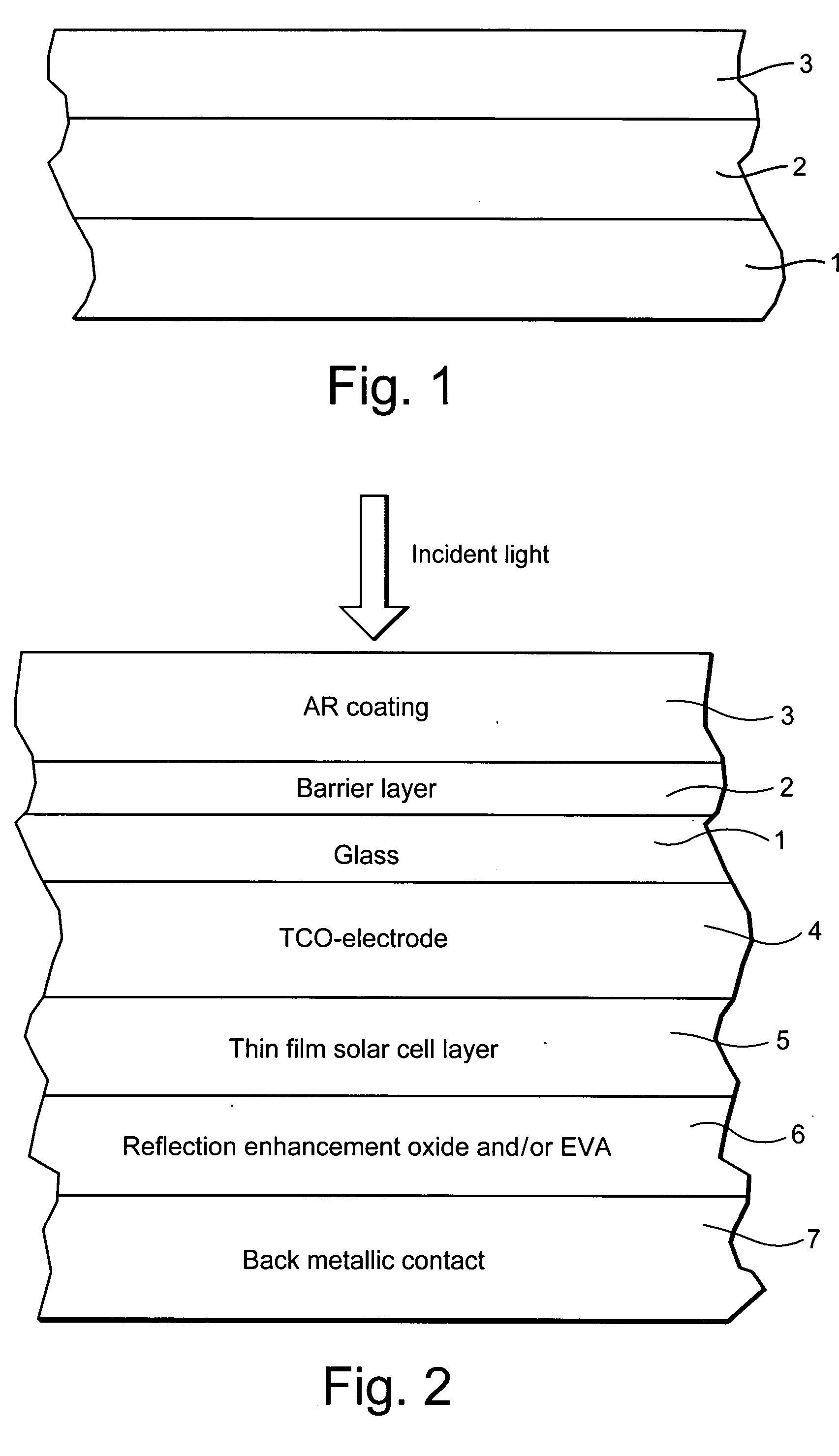Method of making a photovoltaic device or front substrate with barrier layer for use in same and resulting product
a technology of photovoltaic devices and front substrates, applied in the direction of coatings, chemistry apparatuses and processes, transportation and packaging, etc., can solve the problems of reducing the transmission of light and/or radiation through ar coatings, affecting the performance of photovoltaic modules, and less efficient solar cells, so as to inhibit the degradation of substrates
- Summary
- Abstract
- Description
- Claims
- Application Information
AI Technical Summary
Benefits of technology
Problems solved by technology
Method used
Image
Examples
example # 2
EXAMPLE #2
[0060]In Example #2, a barrier layer was used which is made from alumina (Al2O3). 2.52 gm of aluminum tert butoxide was mixed in a solution containing 2 gm acetylacetate, 6 gm of hydrochloric acid and 20 gm of normal propanol. Stir this solution for 15 minutes. Then add 0.5 gm of water. Stir the solution for another 15 minutes. The final solution is refers as Al2O3 sol. The barrier layer of almuna was fabricated using spin coating method with 1000 rpm for 18 secs. The coating was heat treated in furnace at 130° C. for one minute. Then the coating was cooled down to room temperature. AR coating of silica was cast on the barrier layer exactly same method mentioned in the example #1. The coatings were also subjected to the environmental testing as illustrated in the Example #1. Transmission was measured before and after the environmental testing and result shows in table 2.
example # 3
EXAMPLE #3
[0061]In Example #3, a barrier layer was used which is made from zirconia (ZrO2). 3.8 gm of zirconium butoxide was mixed in a solution containing 2 gm acetylacetate, 6 gm of hydrochloric acid, 2 gm of nitric acid and 20 gm of normal propanol. Stir this solution for 15 minutes. Then add 0.5 gm of water. Stir the solution for another 15 minutes. The final solution is refers as ZrO2sol. The barrier layer using zirconia and top layer of AR coating are fabricated exactly similar method as mentioned in example #2. The coatings were also subjected to the environmental testing as illustrated in the Example #1. Transmission was measured before and after the environmental testing and result shows in table 2.
example # 4
EXAMPLE #4
[0062]In Example #4, a barrier layer was used which is made from mullite (3Al2O3:2SiO2). Mullite sol containing 3 parts of alumina and 2 parts of silica was prepared by taking 2.18 gm of aluminum tert butoxide and 0.73 gm of glycycloxylpropyltrimethoxysilane (glymo) in a solution containing 6 gm acetylacetate, 6 gm of hydrochloric acid and 20 gm of normal propanol. Stir this solution for 15 minutes. Then add 0.5 gm of water. Stir the solution for another 15 minutes. The final solution is refers as 3Al2O3:2SiO2 sol. The barrier layer using mullite and top layer of AR coating are fabricated exactly similar method as mentioned in example #2. The coatings were also subjected to the environmental testing as illustrated in the Example #1. Transmission was measured before and after the environmental testing and result shows in table 2.
PUM
| Property | Measurement | Unit |
|---|---|---|
| temperature | aaaaa | aaaaa |
| temperature | aaaaa | aaaaa |
| thickness | aaaaa | aaaaa |
Abstract
Description
Claims
Application Information
 Login to View More
Login to View More - R&D
- Intellectual Property
- Life Sciences
- Materials
- Tech Scout
- Unparalleled Data Quality
- Higher Quality Content
- 60% Fewer Hallucinations
Browse by: Latest US Patents, China's latest patents, Technical Efficacy Thesaurus, Application Domain, Technology Topic, Popular Technical Reports.
© 2025 PatSnap. All rights reserved.Legal|Privacy policy|Modern Slavery Act Transparency Statement|Sitemap|About US| Contact US: help@patsnap.com


